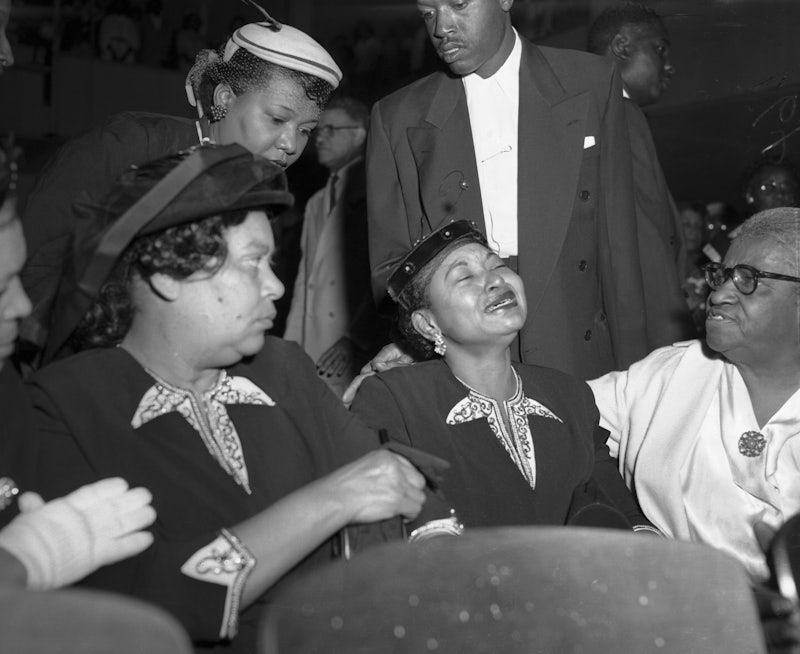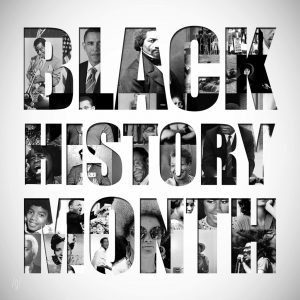Mamie Till-Mobley wrote her memoir, Death of Innocence: The Story of the Hate Crime That Changed America, in 2003, the same year she died of heart failure, and 47 years after the lynching of her son, Emmett Till. “When I am out and about,” she explained, “people recognize me and they want to talk about him, what his death meant to them, what I mean to them still. They just can’t help it.”
If the public’s curiosity about Till-Mobley’s suffering had come to seem natural over the years, it was in part because she established a tradition of victims’ families publicly grieving for the lives taken in brutal racist attacks. It is thanks to Till-Mobley that those of us who are familiar with Emmett Till’s story know him through a few select images, those she decided to make public after his death. In the first of these photos I ever saw, a 13-year-old Till sports a wide-brim hat and the kind of nonsmiling smile of the reluctant subject of a photograph. In another, taken that same Christmas Day in 1954, he is faintly grinning, and if you look hard enough at his round, unblemished face you can see the outline of a mustache growing above his lips—the kind of facial hair a boy anxious for the world to call him a man may be a little too proud to show off.
And then there’s the most famous photograph of Till, one in which none of these features can be distinguished because they no longer exist. Lying dead in his casket, his face is recognizable as a face only because we know where eyes, ears, nose, and mouth are supposed to be. It is this photo that his mother wanted published in Jet magazine and The Chicago Defender, leading black publications of the time. “People had to face my son and realize just how twisted, how distorted, how terrifying race hatred could be,” she wrote in her memoir. “The whole nation had to bear witness to this.” It is also this photo—evidence of Till’s lynching at the hands of two white men from Money, Mississippi—that helped to launch the civil rights movement. “I thought of Emmett Till,” Rosa Parks said in 1956, “and when the bus driver ordered me to move to the back, I just couldn’t move.”
Mamie Till-Mobley’s memoir keeps company in a small literary subgenre alongside books by Myrlie Evers-Williams and Coretta Scott King, the widows of assassinated civil rights leaders Medgar Evers and Martin Luther King Jr. In 2013, the year after Trayvon Martin was killed, Jesmyn Ward published her gorgeous memoir, Men We Reaped, which chronicles the lives and deaths of five young black men, including Ward’s brother, in her hometown of DeLisle, Mississippi. In the wake of Trayvon’s death and the acquittal of his killer, George Zimmerman, Ward’s stories of these unrelated black men served as a stand-in for Trayvon’s story. Now his parents, Sybrina Fulton and Tracy Martin, have published their own book about his life and death, while Lezley McSpadden has told the story of her son, Michael Brown, and his killing at the hands of a white police officer in Ferguson, Missouri. These works are an outlet for grief, but also part of what has become an obligation for black families to mourn in public.
In an America where mass shootings are a common occurrence, there is no shortage of white people who have lost loved ones in a highly publicized tragedy. But the responsibilities foisted on them are not the same: Relatives of white victims can choose to become activists—they might take up, say, the cause of gun control—but they aren’t required to, and they never have to, prove that their very lives have value. Their grief is their own. Black grief belongs to the world, and is regulated by the same forces that caused such deep pain in the first place. Black families become advocates, activists, and spokespeople, historians, journalists, and policy experts, while also being the gatekeepers of the legacy and humanity of those they’ve lost.
And they must somehow do all of this while comforting a society that both produced the conditions for these tragic deaths and still refuses to acknowledge its role in them. If the condition of black life is one of mourning, as Claudia Rankine has reflected, we should at least be able to own our own tears.
In the five years since George Zimmerman, a neighborhood watchman, shot and killed Trayvon in Sanford, Florida, Trayvon has often been referred to as this generation’s Emmett Till. That’s a heavy distinction to bear, for reasons beyond the loss. Branding a black child’s death as the latest incarnation of Till’s recognizes that there exists a 60-year period during which the conditions that produced Till’s brutal killing have remained relatively unchanged.
Till-Mobley waited until the end of her life to tell her and her son’s story. “It took quite a while for me to accept how his murder connected to so many things that make us what we are today,” she wrote, but she came to see that “there was an important mission for me, to shape so many other young minds as a teacher, a messenger, an active church member.” Her responsibility, as she saw it, was to children like Trayvon, who would be able to read what happened to Emmett—or Bo, as she called him—and to see what white supremacy is capable of. In their joint memoir, Rest in Power: The Enduring Life of Trayvon Martin, Sybrina Fulton and Tracy Martin—they write alternating chapters—describe how, in fact, they raised their son to stay on guard in this very way. Tracy Martin writes:
I knew good and well that if there was a racial confrontation, no matter the right and wrong of it, the black person involved would be saddled with the presumption of guilt…. A generation later, I had to give my sons the same instructions my mother gave me.
Education and vigilance were, of course, not enough. “Progress,” Trayvon’s father adds, “is sometimes hard to find.”
Some of this work of grieving is undeniably gendered: Fulton and Martin’s memoir is an anomaly in that Martin, as the father, is a participant in telling Trayvon’s story. He recalls what their attorney told him in the early days of media coverage: “We have to get Sybrina involved. She’s the mother, and people need to hear from her.” His voice, in short, will resonate less than Sybrina’s. It is the mother’s pain we want, the mother’s tears and anguish. When racist violence kills their children, black women are called forth to perform a version of womanhood that is meant to convince white people they value motherhood and to soothe white fear. Black women must be devastated, but not angry. They must stand up for their children, but never question the system. They must fight for justice, but forgive everyone when none is delivered. And when the dust settles, and white people have decided that the “race conversation” has run its course, the mothers must quiet themselves and fade away, until white people decide it’s time for the families to perform their grief once more.

It is no doubt because of the fraught nature of grieving that people reacted so strongly to Dana Schutz’s painting of Emmett Till at the Whitney Biennial earlier this year. Some said that Schutz, as a white artist, could never understand the nature of the racial violence that her painting depicted. She defended herself by shifting the focus from race to gender. “I don’t know what it is like to be black in America,” she said, “but I do know what it is like to be a mother…. The thought of anything happening to your child is beyond comprehension. Their pain is your pain.” On one level, that may be true. But as Fulton’s chapters underscore, there are aspects of motherhood that an artist not connected to this history would struggle to notice, much less convey in a work of art.
Rest in Power is difficult to read, in part because Sybrina Fulton and Tracy Martin did not ask to become authors. The pain of their obligation hangs over every page, every sentence. They are not professional writers choosing to make beautiful sentences out of the darkness as their vocation—as Jesmyn Ward does brilliantly in her memoir. In Men We Reaped, Ward sets out to help us understand what makes her stories important for the rest of us—that acknowledging who killed these young men is a vital part of the healing process:
I write these words to find Joshua, to assert that what happened happened, in a vain attempt to find meaning. And in the end, I know little, some small facts: I love Joshua. He was here. He lived. Something vast and large took him, took all of my friends. Roger, Demond, C.J., and Ronald. Once, they lived. We tried to outpace the thing that chased us, that said: You are nothing. We tried to ignore it, but sometimes we caught ourselves repeating what history said, mumbling along, brainwashed: I am nothing…. There is a great darkness bearing down on our lives, and no one acknowledges it.
Where Ward’s was a private grief made public, Fulton and Martin’s grief was never fully their own. They are charged with taking a story that many of us feel connected to and filling in the personal details we did not know. Their son’s death gripped a nation and sparked a movement. There is a built-in understanding of what is important about their story; the function of their grief is not to illuminate. What is being asked of them is to turn their personal pain into a healing process for the rest of the country. The same nation that denies that the problem of racist violence even exists asks the most vulnerable to diagnose and treat it.
Over and over again, Tracy Martin reiterates that he is a truck driver. In other words, he is an ordinary man, with an ordinary job, trying to lead an ordinary life. He didn’t set out to be an activist or an expert on the Stand Your Ground policy that allowed Zimmerman to escape any legal responsibility for Trayvon’s death; Martin wanted only to provide a decent life for himself and his children. “All I wanted was to be a mother, to work at my job and raise my kids and live a normal life,” Fulton writes, echoing her ex-husband’s sentiment. “Then my son was killed and that world went with him.” Her new world is one in which she must perform her grief, not only because of a public desire to know, but because of a public penchant for distorting the victims’ characters.
If Fulton and Martin’s book lays bare the work of grieving, Michael Brown’s mother, Lezley McSpadden, has taken on an even bleaker task: the labor of rehabilitating her son’s image. “Michael Brown, 18, due to be buried on Monday, was no angel,” The New York Times wrote less than three weeks after he was shot by Ferguson police officer Darren Wilson. After much outrage, Margaret Sullivan, the newspaper’s public editor at the time, acknowledged that it was an “ill-chosen phrase.” But the piece accurately reflected a narrative that had formed about Brown. Video had surfaced that showed him aggressively handling a cashier at a convenience store and allegedly stealing a pack of cigarillos shortly before he was shot in the street by Wilson. That was enough to convict Brown—not of stealing or assault, but of the higher crime of being a “bad nigger.”
In polite society today, of course, no one would actually say those words aloud. (Though in a day and age when a candidate can be elected president after referring to “bad hombres” and “nasty women” on the campaign trail, it’s not hard to imagine that “bad nigger” is only biding its time until it is once again socially acceptable.) But the same narrative repeated itself in killing after killing. Eric Garner’s death at the hands of an NYPD officer in Staten Island earlier that year became an indictment of Garner’s illegal activity of selling loose cigarettes; Sandra Bland’s mysterious death in a Texas jail cell in 2015 was reduced to her “mouthing off” and failing to comply with an officer during a traffic stop.
In Tell the Truth & Shame the Devil: The Life, Legacy, and Love of My Son Michael Brown, McSpadden sets out to make clear that while her son may have been “no angel,” he was human. He was a person with goals. He was kind, gentle, a caring friend, and a son she loved with all her heart. Not only was his life taken from her, but in death he was defined as something other than the son who brought her joy. And now it has become her responsibility to set the record straight.
“I wasn’t there when Mike Mike was shot,” she writes. “I didn’t see him fall or take his last breath, but as his mother, I do know one thing better than anyone, and that’s how to tell my son’s story, and the journey we shared together as mother and son.” Her book, which includes a foreword by Myrlie Evers-Williams, largely recalls Brown’s life before he was killed. She writes lovingly of his affinity for music from an early age, and less so about her struggles to raise him as a teenage mother who faced abuse at the hands of his father. Mostly, what she strives to get across is that before Wilson killed her son, Michael Brown was working hard to live a normal life. Even if the rest of the world never comes around to embracing Michael Brown as human, with all of the contradictory and complex characteristics implied by the term, his mother now owns her own narrative of his life. In these pages, he exists, whole and loved.
Yet it should never have been Lezley McSpadden’s job to reclaim the story of her son’s death. Part of owning the narrative must be the ability to grieve on your own terms. On April 29 this year—the twenty-fifth anniversary of the day four LAPD officers were acquitted in the beating of Rodney King, an act of injustice that ignited the L.A. riots—15-year-old Jordan Edwards was shot and killed by Roy Oliver, a white police officer in Balch Springs, Texas, who fired his rifle into a car full of teenagers leaving a party. In a statement released ahead of Edwards’s funeral, his family wrote:
At this time, we ask that you please be respectful of our family, and allow us the opportunity and space to grieve. This entire ordeal has been inescapable.
And in a second statement: “Though we understand what his life and death means symbolically, we are not ready to make a martyr of our son.” In the absence of justice, perhaps progress is simply returning to black families their right to grieve in peace.

